Review: “Orca Safety Buoy with Pocket” Open Water Swim Buoy
The Orca Safety Buoy with Pocket Swim Buoy is premium priced compared to most other options for this essential piece of open water swimming gear. But the Orca boasts design choices and features are likely to justify that cost for some swimmers.
Date: March 9, 2024
The Orca Safety Buoy with Pocket (open water swim buoy or ‘tow float’ outside North America) is premium priced at $US 64.95 (Amazon and Triathlete Sports in the US as of this review). This is a significantly more costly (3x the price of some minimalist options) than most other options for this essential piece of open water swimming gear. But the Orca boasts unique design in several features that hint at upgrades that make this open water swim buoy different from others under review:
-
The namesake pocket: an external mesh pocket for in-water access to nutrition, water bottle, phone/camera, or other needs (note that Orca also offers a model without the pocket the Orca Safety Buoy, at a lower cost, $US48.95 as of this review,
-
A large dry bag capacity that can give additional options for planning or arriving to a swim, and
-
Premium materials and construction, including an easier and almost foolproof inflation valve.
Will this be worth the steep price for your swim? Read on to learn more.
.
Buoy size
The manufacturer’s description of capacity is “Buoy occupies a volume of 9 liters”. This suggests that their measure of volume is much different than the obviously smaller (both in dimensions and apparent volume) buoys designated as “20L” buoys (i.e., New Wave Swim Buoy for Open Water Swimmers and Triathletes – 20L or T6 20L Swim Buoy).
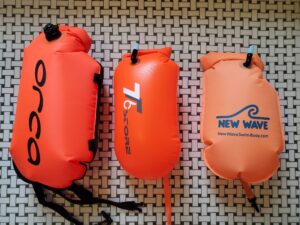
To make sense of the volumes, OpenWaterLog measured the volume of all buoys in a standardized way to ensure an apples-to-apples comparison. Volume of the buoy was measured like this:
-
Deflate the bladder and close the fill valve.
-
Filled the dry bag with water up to the line on the bag where the closure strip can be folded 4 times, and the buckle closed. (In each case, first overfilling beyond the ability to fold 4 times, then pouring out water gradually to reach a 4 folds).
-
Measure the volume of water as poured out of the dry bag.
Measured volume of the Orca buoy for open water swimming comes out to be 11.1 liters, significantly more capacity than the buoys with size advertised as “20L” (T6 20L Swim Buoy measures 8.0L, New Wave Swim Buoy – 20L is 8.8L).
.
Other than this comparison between brands, liters of capacity is admittedly unhelpful to gauge the capacity of the float: is 11L of gear enough? However you measure it, capacity of the Orca dry storage bag is larger than others tested, and is impressive in what that extra volume allows. The Orca permits storage and towing of enough dry land clothes needed for arriving at the water, even dressed for cool or cold season, stashing everything in the float for safe storage during the swim, then changing back into dry clothes for the return. As an example of how much can fit into the Orca swim buoy, our test included
-
Running shoes, size 11 US (44 EU) and socks
-
Mid-weight sweatpants
-
Men’s medium fleece hoodie
-
Men’s medium t-shirt
-
Lightweight towel,
-
Minimalist unstructured backpack (big enough for carrying all of these things plus wetsuit on dry land; we used the MEC Travel Light Daypack),
-
Mobile phone in a dry case in the outer mesh pocket.
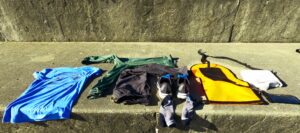
.
There is enough room for all of these items loaded into the dry bag while permitting four turns of the closure strip, best practice for keeping it all dry. In warm weather (or with smaller shoes than the example above) you’ll use less space for dry land gear.
.
In practice the bladder and dry bag are competing for the same space. The more gear inside the dry bag, the less space remains for the bladder (following best practice of loading the dry bag, closing, then inflating the bladder). But even at maximum packing of the dry bag as above, the bladder readily inflates enough to permit not only the buoyancy of the float itself, but as much support as we needed to rest and float, supported by the buoy.
.
Why do you need this much dry bag capacity? You don’t need it if you arrive to a swim in a car, and only need to stash car keys for the swim, or if there is a locker (like at Ohio Street Beach in Chicago), a group of friends watching your gear, like at Aquatic Park in San Francisco, or other secure storage. On the other hand, for swimmers that want to bike, run, walk, or take public transit to the open water swim site, a higher capacity buoy allows the swimmer to be completely self contained. This allows for planning many different kinds of open water swim routes, for example:
-
Bike to a distant swim spot, swim, then bike home
-
Take a rideshare or public transit to new swim site, (like we did at the La Jolla Cove near San Diego),
-
Formulate a new point-to-point swim route (rather than out & back) by traveling to a new entry point, then swimming one-way to the finish. For example, run to a distant swim spot, swim, then run to a new finishing spot, like we did in an open water swim outside Belmont Harbor in Lake Michigan in Chicago.
.
Triathletes take note: in addition to the the usual triathlon brick workout (bike + run), the buoy allows a couple options to combine the swim with a run or bike.
.
What if this extra capacity is more than you need on days when all that gear isn’t necessary? The capacity does comes with the cost of carrying the somewhat heavier Orca (our scale showed 13.5oz / 383g), versus our weight for the New wave (12oz/340g) and the minimalist T6 (9.5oz / 269g). And it’s a little larger: rolled-up length is 14″/36cm vs 13″/23cm (the New Wave) or 11″/28cm (the T6). The difference in feel of the larger bag in the water is undetectable. Functionally, there’s no need to fill the dry bag; the buoy can be used like the New Wave Swim Bubble (a float without dry bag). Handling the incrementally larger size out of the water (i.e., in a backpack) might be noticeable to some swimmers.
.
Construction and Materials
The Orca uses a TPU (Thermoplastic Polyurethane) waterproof shell. Supplier information claims “It has high abrasion and scratch resistance”, similar to other claims for TPU based shell materials compared to PVC shell material of lower cost items. The Orca also adds a strip of woven nylon material around the edges and seams of the buoy. This softens the feel of the edges and seems to provide some additional durability to the edges, inhibiting the fraying of the woven shell material after some use seen in some other buoys.
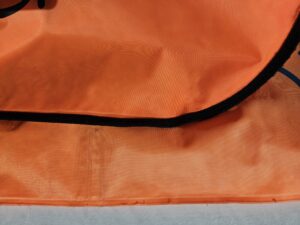
Thought this review didn’t do a structured test of abrasion or scratch resistance, a full year of testing in varied conditions at times dragged through sand, over concrete seawall, repeated packing/unpacking, etc. led to a few areas on the shell that seemed superficially abraded (as in the other buoys tested), though none that led to leakage or evident progress toward leakage.
.
The color is “High-vis Orange”, which is bright enough to be very visible even to distracted kayakers and other boats, fulfilling a very important safety function. The buoy’s larger size adds to visibility from a distance. After a year of use, the color remains vibrant, any fading is subtle.
.
The two-stage inflation and deflation valve is a design element that distinguishes the Orca from alternatives. The other buoys tested have a 1/2″ (1.3cm) diameter valve that can be screwed open or closed, used for both inflation and deflation. The Orca is inflated/deflated with two separate valves (photo), each operated separately. Inflation is done via the outer valve, adding air via a one way valve (air only enters) and a separate valve (for deflating).

Inflation Valve Open
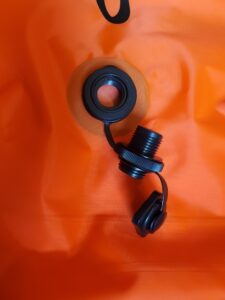
Both Valves Open
.
Most important and useful in this is the one-way inflation-only valve: no air escapes the bladder when the valve is open. There’s no losing the air we painstakingly added while drawing another breath to continue inflating. This differs from valves on other buoys tested, in which it’s necessary to cover the valve opening or otherwise try to avoid losing air from the bladder. On dry land this seems trivial, it’s not hard to carefully inflate the bladder. The difference is noticeable in the water: most swimmers want to add a bit more air to the flotation bladder after some time in the water, as the contents of the dry bag settle and compress. This is much easier with the Orca, and more importantly, avoids the hazard of two way valves in which inattention, error, or difficulty of handling with very cold hands could lead to loss of all the air, and with it all buoyancy, while trying to re-inflate in the water.
.
The valves are also larger and easy to turn. The outer inflation valve is roughly square shaped, 1″ (2.54cm) across, the inner deflation valve is round 1.5″ (3.8cm) diameter, so that it’s easy to distinguish the appropriate valve by feel. These are both significantly larger than the 1/2″ (1.3cm) diameter valve of other buoys tested, and much easier to open or close each when hands have lost dexterity, due to cold or swim gloves.
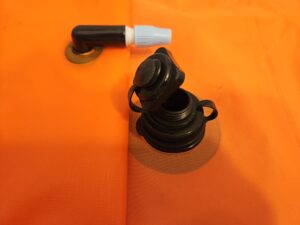
.
Dry Bag Closure
Can you count on keeping everything dry in the dry bag? As long as the best practices for closing the swim buoy were followed, OpenWaterLog didn’t have a single event of water leaking into the dry bag, in dozens of tests, under varied conditions of open water swim temperature and wave height, or dry bag loading. The sealing surface around the edge of the dry bag opening gives 1″ (2.54cm) width folds, and is heavily reinforced with some kind of sewn-in piece to give defined folds in the closure process and sealing that avoids leaks (compared to the 1″ completely unreinforced edge of the T6 in which the folds tend to roll together like a rope and risk some leakage). The material of the sealing surface is the same black woven nylon as in the edging, It doesn’t seem ideal material for sealing the bag, but works well.
The Orca included all needed hardware, including (unlike the T6) a plastic connector that smoothly attaches the waist strap to the tow line for the buoy.
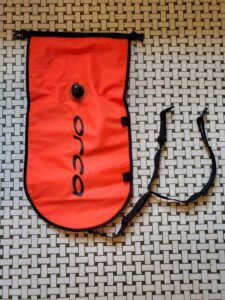
.
Swim Feel
There’s not a lot to distinguish the feel in the water between reasonably well designed buoys for open water swimming. This one felt as good as other commercial buoys: little interference of the strap in kicking, the tow line was long enough to avoid kicking the buoy, little or no sense of resistance in towing, etc. The buoy is heavier as described above and more so with its larger capacity when fully loaded. But this is part of the magic of swim buoys in general: the friction of towing the float is virtually negligible to the swimmer in most conditions.
.
The Pocket
The external mesh storage pocket is the answer to a lot of wish-I-had moments in open water. For swimmers that would find it meaningful to stash close at hand
-
a gel pack or other nutrition,
-
camera for important photo documentation of your swim (whether a waterproof GoPro, or your cell phone in a waterproof/transparent case),
-
small bottle of water from a source more pure than the Open Water in which you’re swimming,
-
spare set of goggles (i.e for changing light conditions or just a spare),
then the Orca might help you.
.
The the exterior pocket footprint measures 8 x 14 inches (20 x 36 cm).
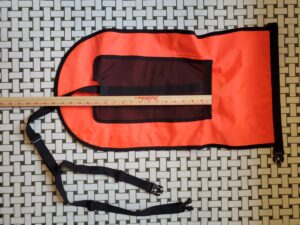
.
The pocket and all contents are fully immersed in the water in the swim, and protrude from the body of the otherwise reasonably hydrodynamic shape of the buoy. Loading the pocket very full with the largest possible items seems to come with more drag than the buoy alone (or even with the same items inside the buoy and inaccessible). The mesh opening at the short end is held reasonably snug by the elastic edge material. The mesh easily stretches enough to hold a 0.5L water bottle, which stays safely in place in our test, and which didn’t escape the buoy during any swims. A larger bike bottle fits, but tests the stretch the pocket if the buoy and air bag are filled to capacity. The tow line running through the pocket and held close along outside of the shell by two guides is a convenient place to loop the neck strap of the dry phone case/phone to secure it in the pocket (preventing loss in the event that case slipped out of the pocket… which never occurred in numerous swims.)
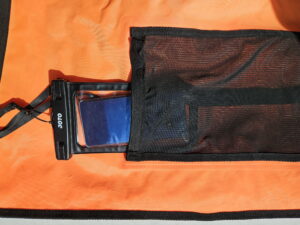
Neck strap of the dry case is secured to the open water swim buoy tow line
.
But, nearly every version of a longer open water swim can leave a swimmer parched: a cold water swim in a wetsuit, a warmer water swim without a wetsuit, and all made more acute by sun exposure or faster pace. A bottle of clean water might be of value to swimmers going long distances in warm conditions.
.
In summary, an open water swim buoy is essential open water swimming gear for a safe and comfortable swim. About the Orca Safety Buoy with Pocket swim buoy:
-
It is a premium priced open water swim buoy at $US 64.95, significantly higher price than most other options.
-
Design choices and features are likely to justify that cost making it the best open water swim buoy for some users, including swimmers who
-
want the ability to be completely self-contained with larger amounts of dry land gear safely towed while in the water, permitting run/bike/public transit to swim, and back.
-
anticipate strong need for in-water access to nutrition, hydration, phone/camera, or other needs,
-
prefer a durable premium build premium fittings and materials, including an easier and almost foolproof inflation valve
-
-
There might be better options for swimmers who value
-
Lower price
-
Very minimalist size, weight, and/or construction for carrying a smaller amount of dry-land gear and minimal space for carrying the buoy around (i.e., in a backpack) or
-
Don’t need in-water access to supplies.
-
